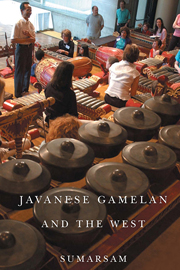Book contents
- Frontmatter
- Contents
- List of Illustrations
- Preface
- Acknowledgments
- Note on Orthography
- Introduction
- Part One Hybridity in Javanese Performing Arts
- 1 Performing Colonialism
- 2 Performing the Nation-State
- 3 Opera Diponegoro
- Part Two Gamelan as Intercultural Object
- Conclusion
- Notes
- Glossary
- Selected Discography
- Bibliography
- Index
2 - Performing the Nation-State
from Part One - Hybridity in Javanese Performing Arts
Published online by Cambridge University Press: 05 September 2013
- Frontmatter
- Contents
- List of Illustrations
- Preface
- Acknowledgments
- Note on Orthography
- Introduction
- Part One Hybridity in Javanese Performing Arts
- 1 Performing Colonialism
- 2 Performing the Nation-State
- 3 Opera Diponegoro
- Part Two Gamelan as Intercultural Object
- Conclusion
- Notes
- Glossary
- Selected Discography
- Bibliography
- Index
Summary
A 1996 newspaper headline in Surabaya proudly proclaimed the unveiling of a new statue in the Javanese city's harbor: “Monjaya, the second largest after [the statue of Liberty].” The inauguration ceremony for the monument— a thirty-meter-high figure of a navy colonel in dress uniform posed atop a twenty-nine-meter-high base—was marked by the sounding of the world's largest gong, named Kyai Tentrem (The venerable sir tranquility). Five meters in diameter, with a one-meter-wide center knob, and weighing 2.4 tons, the gong had to be cut into three pieces for transport and welded back together upon arrival at its permanent location. In fact, the gong was so large that the Indonesian president did not actually strike it during the ceremony (perhaps for the president to pick up such a large mallet to strike the gong would be ceremoniously unsuitable); instead, he struck a smaller replica, leaving the original to be struck later by a navy commander.
This account of the Statue of Liberty-like Monjaya statue and the five-meter gong inspired in me further thought about the cultural interaction between Indonesia (particularly Java) and the West. Current East-West interactions tend to bring about the production of spectacular cultural expression: the Monjaya monument is but one example. The seventy-meter-high Garuda statue in Bali, which has been compared to the Eiffel Tower in terms of height and visual impact, is another. Spectacular cultural expressions—be they monuments, gigantic gongs, or skyscrapers—are obvious representations of Asian-Western cultural hybridity.
- Type
- Chapter
- Information
- Javanese Gamelan and the West , pp. 26 - 53Publisher: Boydell & BrewerPrint publication year: 2013



